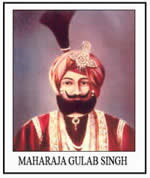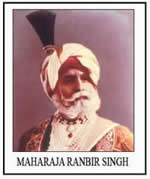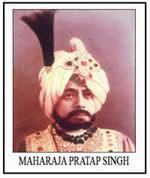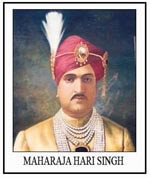HISTORY

Gulab Singh was born on 18 October 1792, a scion of the Jamwal clan of Rajputs. His father, Kishore Singh, was a distant kinsman of Jit Singh, the Raja of Jammu. Gulab Singh grew up in the care of his grand father, Zorawar Singh, from whom he learned the arts of horse-riding and warfare. In 1808, when the Sikh army of Maharaja Ranjit Singh invaded Jammu, the 16-year-old Gulab Singh fought alongside his clansmen in the unsuccessful defense of Jammu. Following this defeat, the Raja of Jammu had internal autonomy of the principality, which became a tributary of the Sikh Empire. In 1809, Gulab Singh enlisted in Ranjit Singh's army, becoming the commander of a Dogra cavalry contingent. He distinguished himself in several campaigns, including the conquest of Multan (1816). He also led an Independent campaign in 1816 to conquer the hill-town of Reasi.
In 1816, following another conflict, Jammu was annexed by Ranjit Singh. Raja Jit Singh, who was expelled, found refuge in British India, and later received in appendage the estate of Akhrota. Ranjit Singh appointed a Governor to administer the newly conquered area which was expanded in 1819 with the annexation of Kashmir by a Sikh force. In 1820, in appreciation of services rendered by the family, and by Gulab Singh in particular, Ranjit Singh bestowed the Jammu region as a hereditary fief upon Kishore Singh. Apart from their sterling services, the family's intimate association with the region commended Kishore Singh's candidature to the Lahore court.
In 1821, Gulab Singh captured conquered Rajouri from Aghar Khan and Kishtwar from Raja Tegh Muhammad Singh. That same year, Gulab Singh took part in the Sikh conquest of Dera Ghazi Khan. He also captured and executed his own clansman, Mian Dido Jamwal, who had been leading a rebellion against the Sikhs.

It was in 1846 that Maharaja Gulab Singh, Founder ruler of the Jammu and Kashmir State created an endowment called the Dharmarth Trust with a personal donation of Rupees Five lacs for the purpose of advancement of holy religion of Hindus, and directed that the interest on this sum be utilized for establishment of Sadabrats, Repairs and renovation of old temples, construction of new temples in J&K State and establishment and maintenance of Goushallas, running of Pathshallas, and other similar charitable purposes.
In 1884 Maharaja Ranbir Singh, son of Maharaja Gulab Singh the Sole Trustee Dharmarth Trust with a view to putting the Trust on a permanent basis and ensuring its proper Administration, promulgated Ain-i-Dharmarth. After the death of Maharaja Ranbir Singh his sons Maharaja Partap Singh, Raja Ram Singh and Raja Amar Singh executed a document declaring that as trustees shall carry out the injunctions laid down in Ain-i-Dharmarth.


Maharaja Hari Singh the Successor of Maharaja Partap Singh Administered the Trust as Sole Trustee in accordance with the Ain-i-Dharmarth. In 1935 under order No. 1 of 1991 (Bikarmi) he restored the Management of Dharmarth Trust to Council, independent of Government, which gives detailed instructions about the formulation of the Council, Management of Dharmarth Trust and Powers/duties of the establishment Delegation orders, code / conduct rules, leave /pension rules and such other rules/procedure have been issued from time to time and amended.

